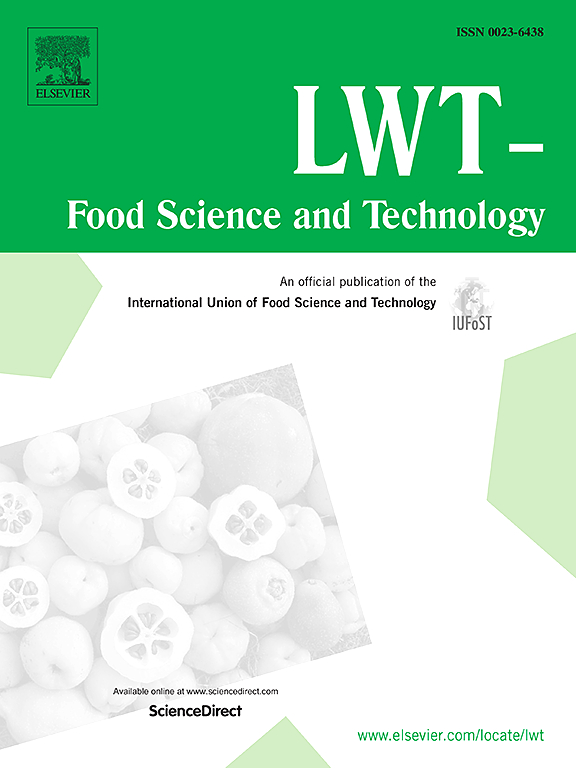探索紫色无壳大麦在挤压即食谷物中的营养和技术功能优势
IF 6
1区 农林科学
Q1 FOOD SCIENCE & TECHNOLOGY
引用次数: 0
摘要
本研究探讨了紫色无壳大麦生产即食谷物的潜力,重点是挤压对其营养和技术功能特性的影响。对四种配方进行了评估:100% 全大麦、100% 珍珠大麦、15% 大麦麸-85% 精制小麦粉和 100% 精制小麦。较高的温度和螺杆速度以及较低的水分含量对膨胀率、密度和硬度有显著影响。全大麦挤压物中含有大量的β-葡聚糖(7.4%)和阿拉伯聚糖(6.8%),它们与膨胀率呈负相关(r = -0.857 和 r = -0.796),与硬度(r = 0.833 和 r = 0.738)和密度(r = 0.673 和 r = 0.863)呈正相关。与整粒大麦相比,珍珠大麦挤压物的质构特性有所改善,但硬度和密度有所降低。比较了原料和挤压物的酚类物质概况和抗氧化能力,发现所有配方的挤压物在挤压后酚类物质概况和抗氧化能力都显著下降。在精制小麦粉中加入大麦麸后,精制小麦挤压物的抗氧化能力提高了三倍。全麦和带珠大麦挤压物的估计升糖指数都很低,适合低升糖指数饮食。总之,紫色无壳大麦是一种营养丰富的挤压产品,其珠光处理和麸皮的利用可为注重健康的消费者提高技术功能和营养品质。本文章由计算机程序翻译,如有差异,请以英文原文为准。
Exploring the nutritional and techno-functional benefits of purple hull-less barley in extruded ready-to-eat cereals
This study explores the potential of purple hull-less barley for producing ready-to-eat cereals, focusing on the impact of extrusion on their nutritional and techno-functional properties. Four formulations were assessed: 100% whole barley, 100% pearled barley, 15% barley bran-85% refined wheat flour, and 100% refined wheat. Higher temperatures and screw speeds, along with lower moisture levels, significantly influenced expansion, density, and hardness. Whole barley extrudates were high in β-glucans (7.4%) and arabinoxylans (6.8%), which negatively correlated with expansion (r = −0.857 and r = −0.796) and positively with hardness (r = 0.833 and r = 0.738) and density (r = 0.673 and r = 0.863). Pearled barley extrudates showed improved textural properties compared to whole barley, with reduced hardness and density. The phenolic profile and antioxidant capacity of raw materials and extrudates were compared, revealing a significant decrease after extrusion across all formulations. Incorporating barley bran into refined wheat flour tripled the antioxidant capacity of the refined wheat extrudates. Both whole and pearled barley extrudates offered a low estimated glycemic index, suitable for low-GI diets. Overall, purple hull-less barley presents a nutritious option for extrusion, with pearling and bran utilization improving both the techno-functional and nutritional qualities for health-conscious consumers.
求助全文
通过发布文献求助,成功后即可免费获取论文全文。
去求助
来源期刊

LWT - Food Science and Technology
工程技术-食品科技
CiteScore
11.80
自引率
6.70%
发文量
1724
审稿时长
65 days
期刊介绍:
LWT - Food Science and Technology is an international journal that publishes innovative papers in the fields of food chemistry, biochemistry, microbiology, technology and nutrition. The work described should be innovative either in the approach or in the methods used. The significance of the results either for the science community or for the food industry must also be specified. Contributions written in English are welcomed in the form of review articles, short reviews, research papers, and research notes. Papers featuring animal trials and cell cultures are outside the scope of the journal and will not be considered for publication.
 求助内容:
求助内容: 应助结果提醒方式:
应助结果提醒方式:


